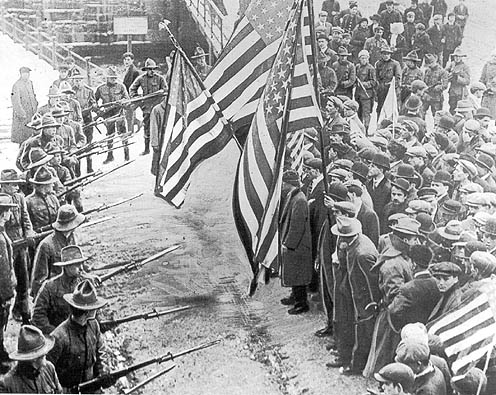
“One may live without bread, but not without roses…”
– Jean Richepin, 19th century French Poet
One hundred years ago this week, 25,000 textile mill workers, many of them women and young girls, walked away from their looms and out of the Dickensian sweatshops of Lawrence, Massachusetts in protest of brutal working conditions and pay cuts. The “Bread & Roses” strike suddenly and unexpectedly thrust the horrible working conditions and massive economic gap of an earlier Gilded Age into the public eye.
Like today’s Occupy Wall Street movement, the Bread and Roses strike merged radical activism and worker militancy. Robert Forrant, a history professor at the University of Massachusetts, calls the strike “the first Occupy movement.”
Progressive Era radicals, in this case the Industrial Worker’s of the World (IWW), or Wobblies, raised the voices of the ninety-nine percent. Representing the unskilled and immigrant workers that mainstream unions and liberal politicians ignored and refused to help, the strike illuminated the plight of families and child labor as it has never been done before.
They pushed the envelope by utilizing direct action tactics such as pickets and a massive strike. In the case of Occupy, it was the call to action put out by AdBusters last summer that was embraced by direct action-istas, anarchists, and radicals across the world. In 1912, the IWW organized Lawrence’s mill workers to stage a multi-month strike in resistance to the American Woolen Company and other Yankee manufacturing bosses.
The strike was partially sparked by liberal workday reforms that hurt these workers and benefited the one percent. Similar to today, Obama-era legislation and (lack of) regulation continues to favor big banks and corporations over poor and working class people. Hence, today’s Occupy movements are made up of, or represent, large numbers of disaffected Americans who have lost their homes, their jobs, have no health care, or are poisoned by the fossil fuel industry.
The manufacturing bosses refused to negotiate with the “scourge of Southern Europe” and instead relied on military force and “divide and conquer” tactics. Without the benefit of MSNBC or YouTube, police and Massachusetts state militia brutalized strikers for months. Two workers were shot or bayoneted to death, while many others were clubbed and jailed. Before the strike, the one-percenters that owned Lawrence pitted ethnic groups against each other, as well as divisions in organized labor that favored skilled workers over unskilled workers.
Much like today’s Occupy Wall Street, the Bread and Roses strike drew a line in the sand between the wealthy “haves” and the “have nots” at the bottom of the socio-economic food chain. Also like Occupy Wall Street, the demands for bread and roses sparked a radical movement of movements fighting for a living wage, better working conditions, and dignity and respect.